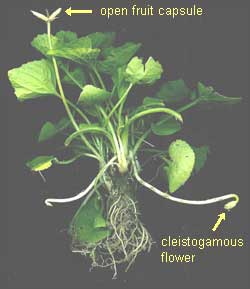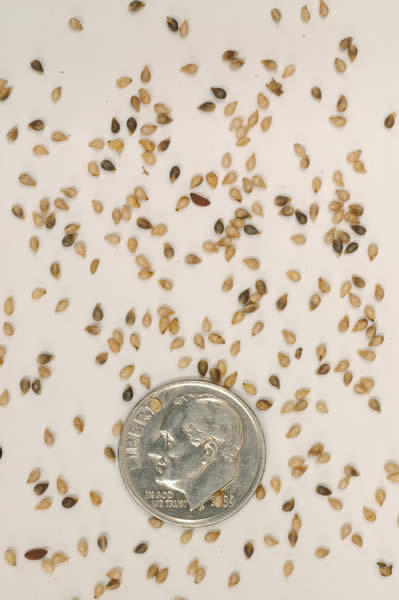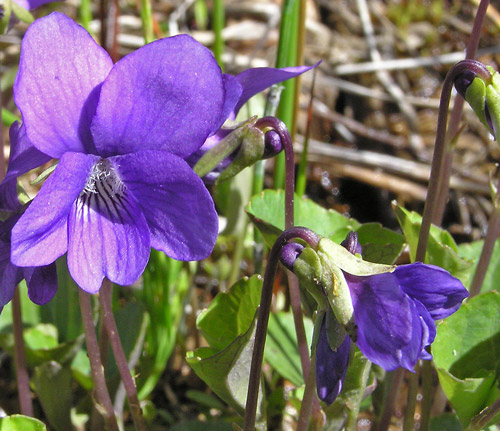“Hath the pearl less whiteness because of its birth? Hath the violet less brightness for growing near earth?” -- Thomas Moore
Reproduction
Growing takes some effort!
Viola sororia is a perennial plant and blooms in early spring through summer. Since it is a flowering plant, it has both male and female reproductive parts and will go through double fertilization, which is explained below. This sexual reproduction cycle of Viola sororia occurs via the chasmogamous (open) flowers in early Spring and the cleistogamous flowers in the summer. Viola sororia is not usually pollinated by insects but sometimes by bees late in the season.
Flower parts:
The flowers of Viola sororia grow on separate stems from leaves. A flower consists of five sepals and five petals. There are also five stamens with their filaments usually fused at the base to form a ring around the ovary. The terminal structure of a stamen is called the anther, which is responsible for holding the microsporangia that produce pollen. The ovary consists of three fused carpels forming one locule which contains the numerous ovules arranged on a pariental placenta. The stigma allows pollen to land and travel down the pollen tube that runs inside the style into the ovules in the ovary. From the bases of the two lowermost stamens, nectar is secreted into a tube-like structure called a spur, formed by the petals.
 The chasmogamous flowers can go through cross-pollination and
self-pollination. Cross-pollination occurs when pollen from an
anther of a flower on one plant is transferred to the stigma of a
flower on another plant of the same species.
The chasmogamous flowers can go through cross-pollination and
self-pollination. Cross-pollination occurs when pollen from an
anther of a flower on one plant is transferred to the stigma of a
flower on another plant of the same species.
During the summer, the cleistogamous flowers will go through self pollination and produce seeds. The anther within the flower will release pollen that goes down along the style to the ovules. Cleistogamous flowers do not open until they release their seeds by mechanical ejection from the three-parted seed capsules.
Double fertilization:
 This is a process in which two sperm cells unite with two cells
in the female gametophyte (embryonic sac) within an ovule to form
the zygote and endosperm, the food storing tissue of the seed. Each
ovule then develops into a seed, while the ovary develops into a
fruit enclosing the seed. Within each seed, the zygot develops into
the embryo and the seed stockpiles proteins, oils, and starch. The
seeds are major
sugar sinks because they use and store a lot of sugar.
This is a process in which two sperm cells unite with two cells
in the female gametophyte (embryonic sac) within an ovule to form
the zygote and endosperm, the food storing tissue of the seed. Each
ovule then develops into a seed, while the ovary develops into a
fruit enclosing the seed. Within each seed, the zygot develops into
the embryo and the seed stockpiles proteins, oils, and starch. The
seeds are major
sugar sinks because they use and store a lot of sugar.
One way for the Common Blue Violet to disperse its seeds is through its mutualistic symbiosis, called myrmecochory, with some species of ants. These ants will carry the seeds and literally plant them in tunnels. Check out this relationship and other symbioses that Viola sororia engages in by going to the Interactions page.
